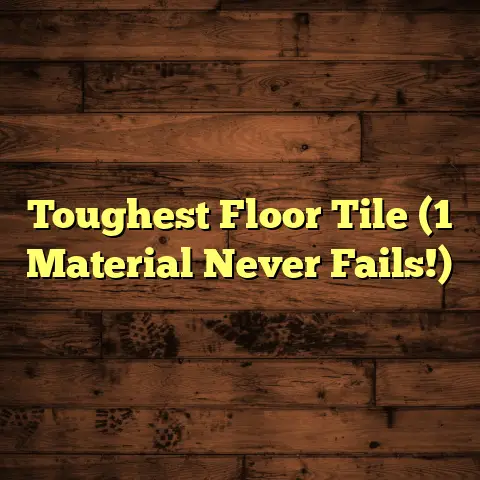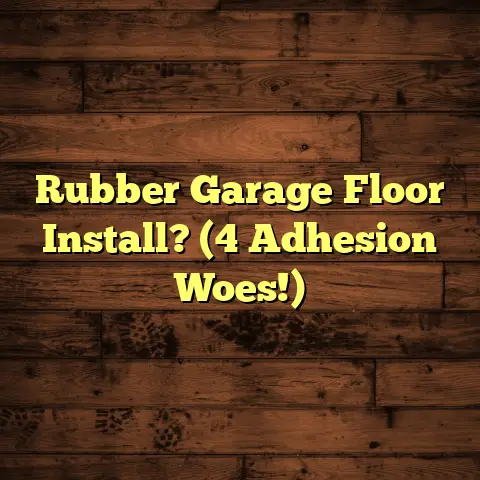Parquet Floors & Expansion (1 Disaster Inevitable!)
There’s nothing quite like the thrill of transforming a space, especially when it involves beautiful flooring.
I remember this one client, Sarah, who was so excited to install a stunning herringbone parquet in her dining room.
She envisioned elegant dinner parties and cozy family gatherings. The transformation was amazing, initially.
But then, a few months later, I got that call. You know, the one where panic is practically audible?
The parquet floor was buckling, and gaps were forming everywhere. Her dream dining room was turning into a nightmare.
Then there was Mark, who opted for a classic chevron parquet in his living room, aiming for a sophisticated, timeless look.
He chose engineered parquet, thinking it would be more stable. However, he skipped a crucial step during installation.
Long story short, the floor started creaking and shifting within the first year, causing him endless frustration.
Parquet flooring is undeniably beautiful. It adds character and a touch of luxury to any home.
Trust me, after countless installations and repairs, I can confidently say that understanding these challenges is crucial for a successful renovation.
Section 1: Understanding Parquet Flooring
So, what exactly is parquet flooring? In simple terms, it’s a type of wood flooring made up of small pieces of wood arranged in a geometric pattern.
Think of it as a mosaic, but with wood instead of tiles. Parquet has a rich history, dating back to the 17th century in France, where it was used in grand palaces like Versailles.
Traditionally, parquet floors were a symbol of wealth and luxury. Over the years, parquet flooring has evolved, and today, you can find it in various styles and materials.
Some popular patterns include:
- Herringbone: A classic zig-zag pattern, resembling the bones of a fish.
- Chevron: Similar to herringbone, but with the ends of the planks cut at an angle to create a continuous V-shape.
- Basketweave: A pattern that resembles woven baskets, with alternating horizontal and vertical planks.
- Versailles: An intricate pattern featuring interlocking squares and diagonals.
As for materials, you have a few options:
- Solid Hardwood: This is the traditional choice, made from solid pieces of wood like oak, maple, or walnut.
- Engineered Wood: This consists of a thin layer of hardwood veneer bonded to a plywood or fiberboard core. It’s more stable than solid wood and less prone to expansion.
- Laminate: This is a synthetic material that mimics the look of wood. It’s affordable and durable but doesn’t have the same warmth and feel as real wood.
The manufacturing process involves cutting the wood into small, precise pieces and then arranging them in the desired pattern. These pieces are then glued or nailed to a subfloor, creating a seamless, visually stunning surface.
Section 2: The Importance of Expansion in Parquet Floors
Alright, let’s talk about the elephant in the room: expansion. Wood is a natural material, and like all natural materials, it reacts to its environment.
Specifically, it expands and contracts with changes in humidity and temperature. This is especially important to understand with parquet floors because of the many small pieces involved.
Think of it this way: each individual piece of wood is trying to expand or contract, and when you have hundreds or thousands of these pieces tightly packed together, the forces can be significant.
According to the National Wood Flooring Association (NWFA), wood flooring can expand and contract up to 1/4 inch per foot of width, depending on the species and environmental conditions. (Source: NWFA Technical Manual)
That might not sound like much, but when you multiply that across an entire room, it can lead to serious problems, like buckling, warping, and gaps.
- Humidity: Wood absorbs moisture from the air, causing it to swell. High humidity levels can lead to significant expansion.
- Temperature Changes: As the temperature rises, wood tends to expand. Conversely, as the temperature drops, it contracts.
- Type of Subfloor: A damp or uneven subfloor can exacerbate expansion issues.
- Acclimation: If the wood is not properly acclimated to the environment before installation, it will expand or contract after installation, leading to problems.
Understanding these factors is the first step in preventing expansion-related disasters. Trust me, a little knowledge can go a long way in saving you a lot of headaches (and money) down the road.
Section 3: Common Issues with Parquet Floors and Expansion
Now, let’s get into the nitty-gritty of what can go wrong. I’ve seen firsthand the havoc that expansion can wreak on parquet floors.
Here are some common issues homeowners face:
- Gaps Between Planks: This is perhaps the most common problem. As the wood shrinks due to low humidity, gaps appear between the individual pieces of parquet.
- Buckling: This occurs when the wood expands and has nowhere to go. The pressure causes the floor to lift and buckle, creating an uneven surface.
- Warping: This is when the individual pieces of wood become distorted or curved. It’s often caused by uneven moisture absorption.
- Squeaking: As the floor expands and contracts, the pieces can rub against each other, causing annoying squeaks.
Remember Sarah, from the introduction? Her dining room floor experienced severe buckling. The humidity in her area spiked during the summer months, and the parquet, which wasn’t properly acclimated, had nowhere to expand. The result was a costly repair and a lot of frustration.
And Mark, with his chevron parquet? His issue was gaps. He didn’t use a moisture barrier, and his subfloor had a slight moisture problem. As a result, the wood dried out and shrank, leaving unsightly gaps between the planks.
Section 4: The Inevitable Disaster
Okay, let’s address the elephant in the room: “1 Disaster Inevitable!” It might sound dramatic, but in my experience, it’s often the reality for homeowners dealing with parquet flooring.
I’m not saying that every parquet floor is doomed to fail, but I am saying that the risk of a major problem is significantly higher if you don’t take the proper precautions.
The most catastrophic scenarios I’ve seen include:
- Complete Floor Replacement: In severe cases of buckling or warping, the only solution is to tear out the entire floor and start from scratch. This is an expensive and time-consuming process.
- Structural Damage: If the expansion is significant enough, it can put pressure on the surrounding walls and structures, potentially causing cracks or other damage.
- Mold and Mildew Growth: If moisture gets trapped under the floor due to expansion issues, it can create a breeding ground for mold and mildew, which can be harmful to your health.
I recall another client of mine, let’s call him David, who installed a beautiful parquet floor in his basement. He didn’t install a proper moisture barrier, and his basement had a history of dampness. Within a year, the floor was completely ruined by mold and mildew. He had to rip it all out, remediate the mold, and install a new floor. The financial and emotional toll was immense.
According to a study by the Institute of Inspection, Cleaning and Restoration Certification (IICRC), water damage is one of the leading causes of flooring failure, accounting for billions of dollars in damage each year. (Source: IICRC S500 Standard)
These disasters aren’t just about money. They’re about the emotional stress, the disruption to your life, and the disappointment of seeing your dream home turn into a source of anxiety.
Section 5: The Science Behind Wood Expansion
Let’s dive into the science behind wood expansion. Understanding why wood expands and contracts is crucial for preventing problems.
Wood is a hygroscopic material, which means it readily absorbs and releases moisture from the surrounding air. This is due to the cellular structure of wood, which contains tiny pores and channels that act like sponges.
When the humidity is high, wood absorbs moisture, causing the cells to swell and the wood to expand. Conversely, when the humidity is low, wood releases moisture, causing the cells to shrink and the wood to contract.
- Wood Species: Different species of wood have different hygroscopic properties. For example, some species are more resistant to moisture than others.
- Grain Orientation: Wood expands and contracts more across the grain than along the grain. This is why parquet floors, with their intricate patterns, are particularly susceptible to expansion issues.
- Moisture Content: The moisture content of the wood at the time of installation is critical. If the wood is too wet or too dry, it will expand or contract after installation, leading to problems.
Seasonal changes play a significant role in wood expansion. During the summer months, when humidity is high, wood tends to expand. During the winter months, when humidity is low (due to heating systems), wood tends to contract.
Section 6: Installation Challenges and Solutions
Here are some critical aspects of parquet flooring installation that can lead to problems:
- Improper Acclimation: This is the most common mistake. Wood needs to acclimate to the environment in which it will be installed for several days or even weeks before installation. This allows the wood to adjust to the local humidity and temperature, minimizing expansion after installation.
- Inadequate Subfloor Preparation: The subfloor needs to be clean, level, and dry. Any imperfections in the subfloor will be magnified in the parquet floor.
- Lack of Expansion Gaps: Expansion gaps are small spaces left around the perimeter of the room to allow the floor to expand without putting pressure on the walls.
- Incorrect Adhesive or Fasteners: Using the wrong adhesive or fasteners can prevent the wood from expanding and contracting properly, leading to buckling.
- Skipping the Moisture Barrier: A moisture barrier is a layer of material that prevents moisture from rising from the subfloor and damaging the wood.
I remember one installation where the homeowner insisted on installing the parquet floor themselves to save money. They skipped the acclimation process and didn’t leave any expansion gaps. Within a few months, the floor buckled so badly that it was impossible to walk on. They ended up having to hire a professional to tear it all out and start over, costing them far more than they would have spent on professional installation in the first place.
Section 7: Preventative Measures
Okay, so how do you avoid becoming another parquet flooring disaster statistic? Here are some key preventative measures:
- Humidity Control: Maintain a consistent humidity level in your home, ideally between 30% and 50%. Use a humidifier during the winter months and a dehumidifier during the summer months.
- Professional Installation: Hire a qualified flooring contractor with experience installing parquet floors. A professional will know how to properly acclimate the wood, prepare the subfloor, and install the floor correctly.
- Regular Maintenance: Clean your parquet floor regularly with a damp cloth and a mild detergent. Avoid using excessive water, which can damage the wood.
- Use Area Rugs: Area rugs can help to protect your parquet floor from wear and tear, and they can also help to regulate humidity levels.
- Inspect Regularly: Keep an eye on your parquet floor for any signs of expansion, such as gaps, buckling, or warping. Address any issues promptly to prevent them from becoming worse.
By taking these preventative measures, you can significantly reduce the risk of expansion-related problems and enjoy your beautiful parquet floor for years to come.
Section 8: The Emotional Toll of Flooring Disasters
Finally, let’s talk about the emotional impact of flooring disasters. It’s easy to focus on the financial costs, but the emotional toll can be just as significant.
I’ve seen homeowners break down in tears over ruined floors. It’s not just about the money; it’s about the disappointment, the frustration, and the feeling of having your dream home turned into a source of stress.
A flooring disaster can disrupt your life, create tension in your family, and leave you feeling helpless and overwhelmed. It can also shake your confidence in your ability to make good renovation choices.
Many homeowners tell me that they feel embarrassed or ashamed when they have a flooring problem. They worry about what their friends and neighbors will think.
The journey toward resolution can be long and arduous. It often involves dealing with contractors, insurance companies, and repair technicians. It can be a stressful and time-consuming process.
However, there is hope. With the right knowledge, precautions, and support, you can overcome a flooring disaster and create a beautiful and functional home that you love.
Conclusion: Lessons Learned
So, what are the key takeaways from all of these stories?
Parquet floors are beautiful and can add a touch of elegance to any home. However, they also come with their own set of challenges, especially when it comes to expansion and contraction.
Understanding the science of wood expansion, taking preventative measures, and hiring a qualified professional are essential for a successful parquet flooring installation.
Don’t underestimate the emotional toll of a flooring disaster. Be prepared to deal with the stress, frustration, and disappointment that can come with it.
But most importantly, remember that you’re not alone. Many homeowners have faced similar challenges, and with the right approach, you can overcome them and create a home that you love.





